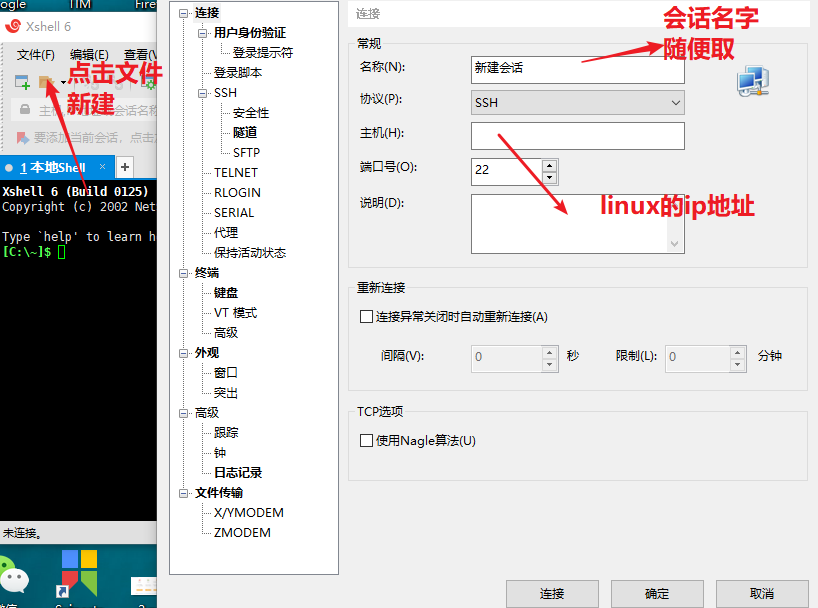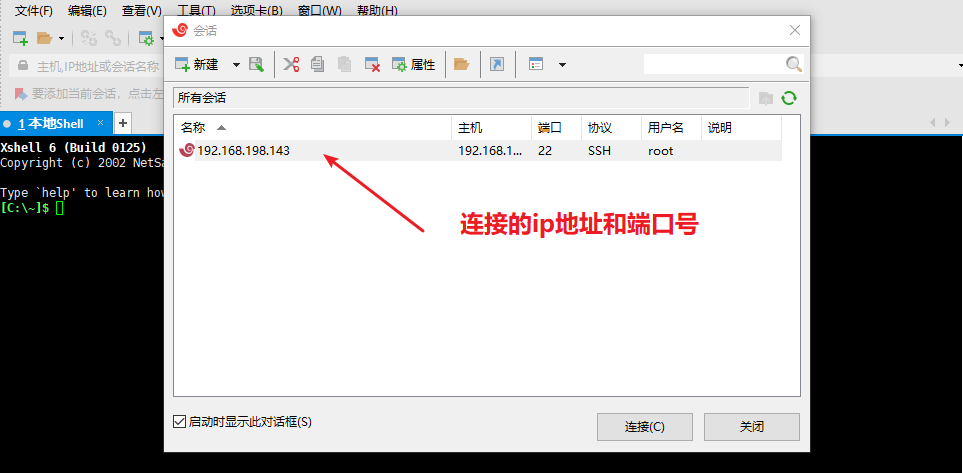目录
一:阿里云服务器
云服务器可以放入自己的项目,可以让所有的人进行访问
需要配置好多环境,比如放上Tomcat,jdk等等
配置安全组及导入实例
不同环境软件对应不同端口,所以需要配置安全组
比如这里我要配置Tomcat对应的安全组,该安全组命名为Linux_Tomcat_8080
(这里可以配置需要的端口号-------什么端口号可以访问)

每个安全组还要导入自己的实例

二:Xshell6
本地和远程服务器进行连接,用于写一些命令对linux进行操作,比如解压
安装
360里找,无脑下一步
连接远程服务器
主机填阿里云服务器的实例的公网ip




三:Xftp
用于本地和服务器进行传输文件
连接远程服务器

连接成功

xftp显示 服务器的隐藏文件
因为服务器为了保护自己的安全,会隐藏一些文件

xshell和xftp的互联
目的就是为了不用二次连接,即不用输入用户和密码两次
在xshell调出xftp,或,在xftp中调出xshell


四:安装jdk
官网下载地址
Java Archive Downloads - Java SE 8u211 and later
(选这个不要选错啦)

打开xftp把jdk的压缩文件传到服务器中,

打开xshell,依次输入命令
进入根目录
cd /root解压
tar -xvf jdk-8u333-linux-x64.tar.gz -C /usr/local进入 /usr/local
cd /usr/local进入编辑
vim /etc/profile文件末尾加入
#set java environment
JAVA_HOME=/usr/local/jdk1.8.0_333
CLASSPATH=.:$JAVA_HOME/lib.tools.jar
PATH=$JAVA_HOME/bin:$PATH
export JAVA_HOME CLASSPATH PATH
按【etc】退出编辑模式
输入冒号:
输入wq保存,点击enter编辑完成
----
加载
source /etc/profile查看版本,有具体版本表示安装成功
java -version五:Zookeeper的安装及配置
下载安装
下载地址Index of /dist/zookeeper(下zk3.5.6和kafka2.4.0版本对应)(得先保证服务器中有jdk环境)
(给4台服务器同时安装Zookeeper,需要打开xshell,分别连接4台服务器,添加4个会话,然后右键选择【发送键输入到所有回话】---这要操作相当于同时操作4台服务器啦)
通过远程工具将本地apache-zookeeper-3.5.6-bin.tar.gz压缩包,分别上传到4台服务器的/opt/software目录

xshell操作
进入压缩包的所在目录
cd /opt/software解压到/opt/module下
tar -zxvf apache-zookeeper-3.5.6-bin.tar.gz -C /opt/module修改文件夹的名字,为zookeeper3.5.6
cd /opt/module
mv apache-zookeeper-3.5.6-bin zookeeper3.5.6配置
1:进入/opt/module/zookeeper3.5.6目录下,创建data 文件夹。
cd /opt/module/zookeeper3.5.6mkdir data2:修改文件名
用xftp操作,进入conf目录, 将mv zoo_sample.cfg zoo.cfg 把 zoo_sample.cfg 改名为 zoo.cfg3:修改zoo.cfg的配置信息
cd /opt/module/zookeeper3.5.6/conf vim zoo.cfg输入i编辑
修改 dataDir=/opt/module/zookeeper3.5.6/data
【esc】退出
:wq
集群配置
1:修改云服务器的hosts的映射和修改本地windows的hosts映射


2:创建并修改myid文件
进入cd /opt/module/zookeeper3.5.6/data下创建myid文件
用xftp编辑myid文件,给每个服务器的myid文件标记唯一编号,分别是1,2,3,4

3:修改zoo.cfg
使用xftp进入 /opt/module/zookeeper3.5.6/data/conf目录下,修改zoo.cfg的内容
myid文件最末尾加入以下内容,4台服务器都要加
quorumListenOnAlllPs=true
server.1=node1:2888:3888
server.2=node2:2888:3888
server.3=node3:2888:3888
server.4=node4:2888:3888
启动zk服务端
(如果是已经进行了集群配置,就不要单个启动一个服务器的Zookeeper啦,否则查看状态报错)
启动 4台服务器(xshell右键,点击【发送键到所有回话】)
cd /opt/module/zookeeper3.5.6/bin./zkServer.sh start启动失败解决Zookeeper无法启动的问题_在京奋斗者的博客-CSDN博客_zookeeper启动不了
查看状态--看看自己事master还是follower-----显示matser或follower就表示搭建集群成功
(如果是已经进行了集群配置,就不要单个启动一个服务器的Zookeeper啦,否则查看状态报错)
./zkServer.sh status停止服务
./zkServer.sh stop启动客户端, 来对服务端进行访问
./zkCli.sh查看节点 (发现有一个【Zookeeper节点】)
ls /退出
quit六:Kafka的安装及配置
下载安装(2.13-2.4.0)
下载地址Apache Kafka (用已经编译好的)(前边2.13表示语言版本,2.4.1表示软件版本)

在每个服务器的/opt目录下,用xftp创建/module文件夹
使用xftp,将压缩包上传至每个服务器的/opt/software目录下

进入root目录
cd /opt/software解压,到/opt/module目录下
tar -zxvf kafka_2.13-2.4.0.tgz -C /opt/module环境变量
在/etc/hosts文件中编辑

刷新
source /ect/profile配置
1:修改云服务器的hosts的映射和修改本地windows的hosts映射


2:用xftp修改/opt/module/kafka_2.13-2.4.0/config下的server.properties文件
# Licensed to the Apache Software Foundation (ASF) under one or more
# contributor license agreements. See the NOTICE file distributed with
# this work for additional information regarding copyright ownership.
# The ASF licenses this file to You under the Apache License, Version 2.0
# (the "License"); you may not use this file except in compliance with
# the License. You may obtain a copy of the License at
#
# http://www.apache.org/licenses/LICENSE-2.0
#
# Unless required by applicable law or agreed to in writing, software
# distributed under the License is distributed on an "AS IS" BASIS,
# WITHOUT WARRANTIES OR CONDITIONS OF ANY KIND, either express or implied.
# See the License for the specific language governing permissions and
# limitations under the License.
# see kafka.server.KafkaConfig for additional details and defaults
############################# Server Basics #############################
# The id of the broker. This must be set to a unique integer for each broker.
############################# Socket Server Settings #############################
# The address the socket server listens on. It will get the value returned from
# java.net.InetAddress.getCanonicalHostName() if not configured.
# FORMAT:
# listeners = listener_name://host_name:port
# EXAMPLE:
# listeners = PLAINTEXT://your.host.name:9092
#listeners=PLAINTEXT://172.19.42.30:9092
# Hostname and port the broker will advertise to producers and consumers. If not set,
# it uses the value for "listeners" if configured. Otherwise, it will use the value
# returned from java.net.InetAddress.getCanonicalHostName().
#advertised.listeners=PLAINTEXT://47.106.250.46:9092
# Maps listener names to security protocols, the default is for them to be the same. See the config documentation for more details
#listener.security.protocol.map=PLAINTEXT:PLAINTEXT,SSL:SSL,SASL_PLAINTEXT:SASL_PLAINTEXT,SASL_SSL:SASL_SSL
# The number of threads that the server uses for receiving requests from the network and sending responses to the network
num.network.threads=3
# The number of threads that the server uses for processing requests, which may include disk I/O
num.io.threads=8
# The send buffer (SO_SNDBUF) used by the socket server
socket.send.buffer.bytes=102400
# The receive buffer (SO_RCVBUF) used by the socket server
socket.receive.buffer.bytes=102400
# The maximum size of a request that the socket server will accept (protection against OOM)
socket.request.max.bytes=1048576000
############################# Log Basics #############################
# A comma separated list of directories under which to store log files
# The default number of log partitions per topic. More partitions allow greater
# parallelism for consumption, but this will also result in more files across
# the brokers.
num.partitions=1
# The number of threads per data directory to be used for log recovery at startup and flushing at shutdown.
# This value is recommended to be increased for installations with data dirs located in RAID array.
num.recovery.threads.per.data.dir=1
############################# Internal Topic Settings #############################
# The replication factor for the group metadata internal topics "__consumer_offsets" and "__transaction_state"
# For anything other than development testing, a value greater than 1 is recommended to ensure availability such as 3.
transaction.state.log.replication.factor=1
transaction.state.log.min.isr=1
############################# Log Flush Policy #############################
# Messages are immediately written to the filesystem but by default we only fsync() to sync
# the OS cache lazily. The following configurations control the flush of data to disk.
# There are a few important trade-offs here:
# 1. Durability: Unflushed data may be lost if you are not using replication.
# 2. Latency: Very large flush intervals may lead to latency spikes when the flush does occur as there will be a lot of data to flush.
# 3. Throughput: The flush is generally the most expensive operation, and a small flush interval may lead to excessive seeks.
# The settings below allow one to configure the flush policy to flush data after a period of time or
# every N messages (or both). This can be done globally and overridden on a per-topic basis.
# The number of messages to accept before forcing a flush of data to disk
#log.flush.interval.messages=10000
# The maximum amount of time a message can sit in a log before we force a flush
#log.flush.interval.ms=1000
############################# Log Retention Policy #############################
# The following configurations control the disposal of log segments. The policy can
# be set to delete segments after a period of time, or after a given size has accumulated.
# A segment will be deleted whenever *either* of these criteria are met. Deletion always happens
# from the end of the log.
# The minimum age of a log file to be eligible for deletion due to age
#log.retention.hours=168
# A size-based retention policy for logs. Segments are pruned from the log unless the remaining
# segments drop below log.retention.bytes. Functions independently of log.retention.hours.
#log.retention.bytes=1073741824
# The maximum size of a log segment file. When this size is reached a new log segment will be created.
log.segment.bytes=1073741824
# The interval at which log segments are checked to see if they can be deleted according
# to the retention policies
log.retention.check.interval.ms=300000
############################# Zookeeper #############################
# Zookeeper connection string (see zookeeper docs for details).
# This is a comma separated host:port pairs, each corresponding to a zk
# server. e.g. "127.0.0.1:3000,127.0.0.1:3001,127.0.0.1:3002".
# You can also append an optional chroot string to the urls to specify the
# root directory for all kafka znodes.
# Timeout in ms for connecting to zookeeper
zookeeper.connection.timeout.ms=6000
############################# Group Coordinator Settings #############################
# The following configuration specifies the time, in milliseconds, that the GroupCoordinator will delay the initial consumer rebalance.
# The rebalance will be further delayed by the value of group.initial.rebalance.delay.ms as new members join the group, up to a maximum of max.poll.interval.ms.
# The default value for this is 3 seconds.
# We override this to 0 here as it makes for a better out-of-the-box experience for development and testing.
# However, in production environments the default value of 3 seconds is more suitable as this will help to avoid unnecessary, and potentially expensive, rebalances during application startup.
group.initial.rebalance.delay.ms=0
#advertised.host.name=47.106.250.46
#advertised.port=9092
#host.name=47.106.250.46
broker.id=1
log.dirs=/opt/module/kafka_2.13-2.4.0/logs
#zookeeper.connect=172.19.42.30:2181,172.19.42.31:2181,172.19.42.29:2181,172.19.42.28:2181
#zookeeper.connect=47.106.250.46:2181,47.106.248.60:2181,47.106.251.169:2181,47.106.251.46:2181
zookeeper.connect=node1:2181,node2:2181,node3:2181,node4:2181
#listener.security.protocol.map=PUBLIC_CLIENT:PLAINTEXT,PRIVATE_CLIENT:PLAINTEXT
#advertised.listeners=PRIVATE_CLIENT://172.19.42.30,PUBLIC_CLIENT://47.106.250.46
#listeners=INSIDE://172.19.42.30:9092,0UTSIDE://47.106.250.46:9093
#advertised.listeners=INSIDE://172.19.42.30:9092,0UTSIDE://347.106.250.46:9093
#listener.security.protocol.map = INSIDE:PLAINTEXT,OUTSIDE:PLAINTEXT
#inter.broker.listener.name=INSIDE
#listeners=PLAINTEXT://172.19.42.30:9092
advertised.listeners=PLAINTEXT://node1:9092
#advertised.listeners=PLAINTEXT://47.106.250.46:9092
log.retention.hours=24
#offsets.topic.replication.factor=3
default.replication.factor=3
delete.topic.enable=true启动(启动kafka之前要集群启动Zookeeper)
进入
cd /opt/module/kafka_2.13-2.4.0启动(不加-darmon表示有日志)
bin/kafka-server-start.sh -daemon config/server.properties查看是否启动成功
先另外开一个窗口

在此窗口输入命令jps
jps
(这个是java带的命令,需要有java环境)

关闭服务
bin/kafka-server-stop.sh七:Tomcat
阿里云的安全组,设置对应端口,并导入实例

进入
cd /rootls
ls解压
tar -xvf apache-tomcat-8.5.81.tar.gz -C /usr/local进入
cd /usr/local开放linux对8080的端口,(默认情况是不开放端口号的)
/sbin/iptables -I INPUT -p tcp --dport 8080 -j ACCEPT进入Tomcat的bin目录
cd apache-tomcat-8.5.81/bin/查看ls
ls启动Tomcat服务 (./表示当前目录,sh是linux系统的启动文件,bat是window的启动文件)
./startup.sh用windows本机的浏览器,访问服务器的Tomcat
(访问出现网址表示成功)

服务器停止Tomcat服务
./shutdown.sh八:宝塔面板
给自己的服务器上安装宝塔面板,然后通过windows本地,可视化安装软件到服务器上
安装宝塔面板
选择在线安装,输入服务器公网ip

阿里云设置端口

开放端口的防火墙
宝塔会自动开启Linux操作系统的防火墙(firewalld.service),如果需要访问某个端口,既需要放通我们自己的服务器安全组,还需要同步在宝塔面板中设置系统防火墙放通对应端口。
(宝塔面板的防火墙的协议,有的时候单的的tcp和tcp/udp都不好使,两个都放上才行)


九:安装MySQL(宝塔面板方式)
安装及配置
宝塔面板里,软件商城搜索mysql,点击安装

修改root密码

创建数据库(按需创建)

修改各个数据库的权限(选择面板方式)

登录用数据库的账号和密码

点击修改权限


点击登录信息(设置在哪些机器上可以登录,这里设置的所有)

阿里云服务器的安全组,设置对应端口

宝塔面板开放防火墙对应的端口(似乎tcp和tcp/udp都要)

navicat连接云服务的mysql






















 332
332











 被折叠的 条评论
为什么被折叠?
被折叠的 条评论
为什么被折叠?








